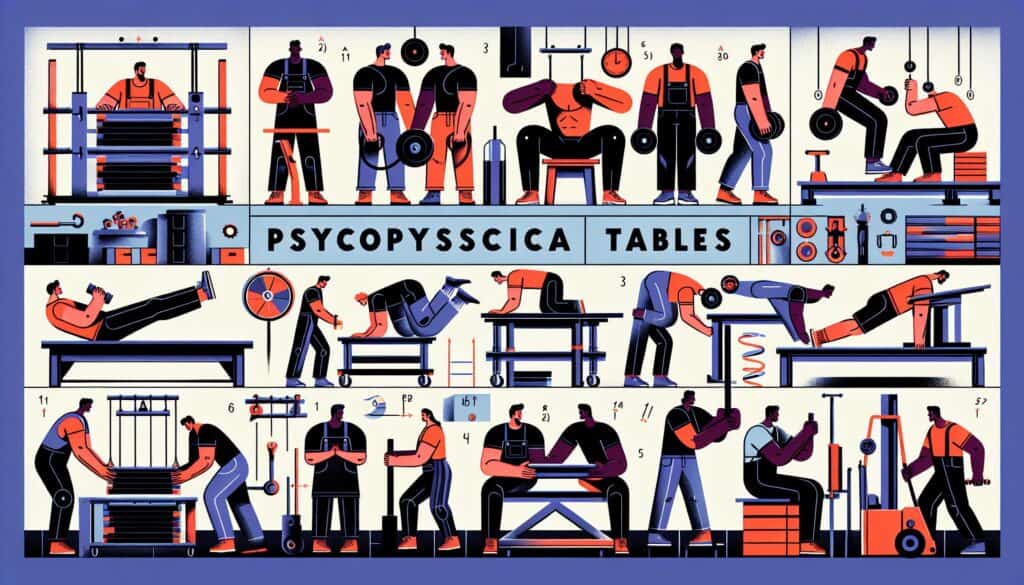根据工业人口中能够在不过度劳累的情况下完成这些任务的比例,为人工材料搬运任务(提升、降低、推、拉、搬运)提供设计目标的表格。
- 方法: 客户与营销, 构思, 产品设计
心理物理表(斯努克表)

- 持续改进, 面向制造设计 (DfM), 可持续性设计, 人体工程学, 人为因素, Human-Centered Design, 流程改进, 风险管理, 安全
心理物理表(斯努克表)
- 持续改进, 面向制造设计 (DfM), 可持续性设计, 人体工程学, 人为因素, Human-Centered Design, 流程改进, 风险管理, 安全
目标
如何使用
- 基于广泛的研究,受试者将任务变量(如重量、距离、频率)调整到其最大可接受水平。表中列出了不同比例的男性和女性的可接受限值。
优点
- 为设计体力搬运任务提供以数据为依据的指南;有助于降低过度劳累受伤的风险;同时考虑男性和女性人群。
缺点
- 数据基于特定的实验室条件,不一定完全适用于所有工作环境;表格的解释和正确应用可能比较复杂;侧重于特定类型的任务。
类别
- 人体工程学
最适合:
- 确定人工材料搬运任务的可接受重量、力量和频率,以适应一定比例的劳动力。
心理物理表(斯努克表)方法为制造业、物流业、医疗保健业和建筑业等普遍采用人工材料搬运的行业提供了宝贵的资源。这种方法根据从不同人口群体收集到的经验数据,确定重量限制和受力公差,从而支持对与各种任务相关的人体工程学风险进行评估,进而优化工作环境和程序。这些行业的雇主可以在设备和工作流程的设计阶段利用这些表格,确保体力要求符合劳动力的能力。在实践中,人体工程学专家和安全工程师通常会使用斯努克表格开展研究,以指导旨在提高职业安全和效率的干预措施。该方法还鼓励项目经理、人力资源人员和人体工程学专家之间开展合作,以营造一个更具包容性的工作场所,使所有员工的体力都能得到充分发挥。通过应用心理物理研究的结果,企业可以创建减少工人疲劳的系统,降低肌肉骨骼疾病的发病率,提高整体生产率,同时保持符合工人健康和安全方面的监管标准。这些数据有助于逐步实施工程解决方案、培训计划和人体工程学评估,不仅有利于公司政策,还能提高员工的福利和满意度。
该方法的关键步骤
- 确定目标人群及其人口特征(如年龄、性别、体能)。
- 开展实验任务,让受试者将变量(如体重、身高、频率)调整到最大可接受水平。
- 汇集收集到的数据,为不同人群的特定任务变量设定可接受的限度。
- 使用统计分析来确定趋势,并为可接受的重量、力和频率阈值制定指导方针。
- 根据男性和女性的阈值创建心理物理表,总结各种任务的可接受极限。
- 在人工搬运任务的设计阶段应用心理物理表。
- 根据反馈意见和在实际环境中的不断观察,迭代和完善任务设计。
专业提示
- 利用斯努克表格,根据百分位数据建立基准,确保任务符合目标人群的能力。
- 根据最新人体工程学研究的建议,在任务设计中纳入可变性,包括对握把类型和姿势等因素进行调整。
- 通过实际测试不断验证和更新心理物理数据,以考虑到不断变化的劳动力人口和能力。
相关文章
肌肉骨骼不适调查表
多变量测试(MVT)
多元回归分析
动作捕捉系统
MoSCoW 方法
情绪中值测试